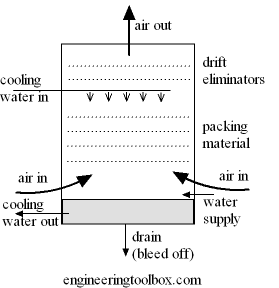Cooling Tower Efficiency
Maximum cooling tower efficiency is limited by the cooling air wet-bulb temperature.
A cooling tower use evaporative cooling to reduce the temperature of circulated water, and
- they can achieve water temperatures below the dry bulb temperature - tdb - of the cooling air
- they are in general smaller and cheaper for the same cooling loads than other cooling systems

Cooling towers are rated in terms of approach and range, where
- the approach is the difference in temperature between the cooled water temperature and the entering air wet bulb temperature - twb - temperature
- the range is the temperature difference between the water inlet and water exit
Note! - for a cooling tower based on evaporative cooling the maximum cooling tower efficiency is limited by the wet bulb temperature of the cooling air.
Cooling Tower Efficiency
Cooling tower efficiency can be expressed as
μ = (ti - to) 100 / (ti -twb) (1)
where
μ = cooling tower efficiency (%) - the common range is between 70 - 75%
ti = inlet temperature of water to the tower (oC, oF)
to = outlet temperature of water from the tower (oC, oF)
twb = wet bulb temperature of air (oC, oF)
The temperature difference between inlet and outlet water (ti - to) is normally in the range 10 - 15 oF.
The water consumption - or the amount of make up water - of a cooling tower is about 0.2-0.3 liter per minute and ton of refrigeration. Compared with the use and waste of city water the water consumption can be reduced with about 90 - 95%.
There are two main types of cooling towers
- forced draught (using fans)
- natural draught
Both types are based on evaporative cooling.
- Natural draught cooling towers are more dependent on temperature gradients between air and water and the wind forces than forced draught cooling towers
- The efficiency of natural draught towers are more variable over time and in general lower
Note! - be aware that a medium temperature system - like cooling a tower - are a known source of pathogenic bacteria causing the Legionnaires disease. Good cleaning and maintenance of the systems are important to minimize the risk.



